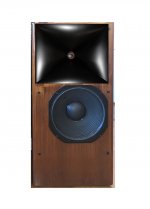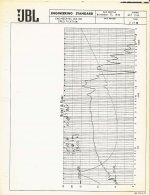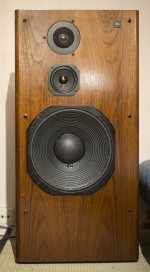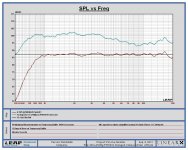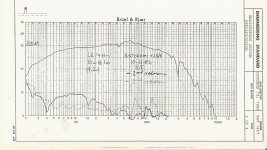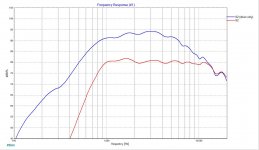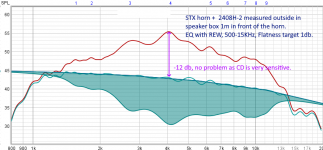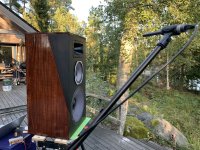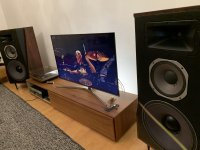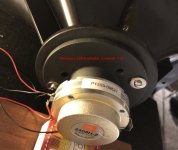Thanks for you tips, spalmgre 🙂.
This looks very cheap? What am I missing?
JBL D2430K Tweeter for JBL M2 #5032754X - Speaker Exchange
I could trim the M2 horns slightly 😛.
This looks very cheap? What am I missing?
JBL D2430K Tweeter for JBL M2 #5032754X - Speaker Exchange
I could trim the M2 horns slightly 😛.
Attachments
The challenge with M2 type speaker is that they are 2 way. How can you extend up and down without leaving a hole in the middle?
Do like Geddes.... add multi subwoofers 😉
Thanks for you tips, spalmgre 🙂.
This looks very cheap? What am I missing?
😛.
I have also been looking that the prices has come down. The horn is also 250$.
A few years ago they were at least double.
Very difficult to think that there is a price war. But there has certainly come interesting alternatives to the market.
Eminence N314T-8 219.99$ goes low and reach hi without breaking up. Carbonfiber against beryllium perhaps.
Look here for a project where the M2 horn is being cut.
Seabackman is the person I referred to in an earlier post who has been using the same VTX horn that I have been using. He wright that the difference between M2 and VTX horn is small so he uses both.
Seabackman is the person I referred to in an earlier post who has been using the same VTX horn that I have been using. He wright that the difference between M2 and VTX horn is small so he uses both.
Last edited:
Another solution is to keep them passive and modify the network in the 240Tis, let them cross at 900hz as is, and let the 2450SLs play from there up. (Would need some attenuation).
That is simply not going to work. You would need a complete redesign especially on the horn side. You need to do a compensation network for the CD/Waveguide combo and I doubt the stock low pass will work. You can probably cross the CD/Waveguide lower depending on measurements.
Rob 🙂
Last edited:
Do like Geddes.... add multi subwoofers 😉
It is not only Geddes who thinks this way. Floyd Thoole is also speaking and writing that multi subs is the way to go. There is a thread about how Thoole has implemented this in his own house.
My next build will rely on satellites with multi subs.
Pth horn (i use older but had the newer), wouldn't cross it below 1.2khz
12" wide and 3" deep, both of them.
Horn in 821 looks like it (pth square horns).
12" wide and 3" deep, both of them.
Horn in 821 looks like it (pth square horns).
It is not only Geddes who thinks this way. Floyd Thoole is also speaking and writing that multi subs is the way to go. There is a thread about how Thoole has implemented this in his own house.
My next build will rely on satellites with multi subs.
I know 😉 just finished the chapter in his book about the subject yesterday...... aaaand have been using multi sub for years 🙂
Wow, thanks... 🙂Look here for a project where the M2 horn is being cut.
Seabackman is the person I referred to in an earlier post who has been using the same VTX horn that I have been using. He wright that the difference between M2 and VTX horn is small so he uses both.
Thanks, good to hear - I can put it out of my mind 🙂. I've read a lot of your posts here, thanks for sharing your experiences.That is simply not going to work. You would need a complete redesign especially on the horn side. You need to do a compensation network for the CD/Waveguide combo and I doubt the stock low pass will work. You can probably cross the CD/Waveguide lower depending on measurements.
Rob 🙂
Ok, I've been wondering about the crossover frequency. How high could the LE14-H cross, I wonder?Pth horn (i use older but had the newer), wouldn't cross it below 1.2khz
12" wide and 3" deep, both of them.
Horn in 821 looks like it (pth square horns).
I've read quite a bit of your trials too, very grateful to read your experiences!
"Horn in 821 looks like it (pth square horns)" - don't follow you here?
14h ?
14” driver ?
I stick with 90 degree dispersion rule (approximately).
8” @ 2khz
12” @ 1.2khz
15” @ 750-800hz.
People don’t, and that’s fine too, for them.
The horn profiles are similar looking.
I like the curved gradual horn walls.
14” driver ?
I stick with 90 degree dispersion rule (approximately).
8” @ 2khz
12” @ 1.2khz
15” @ 750-800hz.
People don’t, and that’s fine too, for them.
The horn profiles are similar looking.
I like the curved gradual horn walls.
Last edited:
Around 1kHz ±a wee bit if you want to match up with a 90° waveguide.
The venerable QSC/B52 14"x10" waveguide would work nicely, if you can find one. There are many 1" CDs that can cross at 1kHz for home hifi applications (and Radian model, B&C DE250, either of the 2 Peerless models, many others I'm sure).
The venerable QSC/B52 14"x10" waveguide would work nicely, if you can find one. There are many 1" CDs that can cross at 1kHz for home hifi applications (and Radian model, B&C DE250, either of the 2 Peerless models, many others I'm sure).
Yes, the LE14H was used in the 240Ti and more known 250Ti. The 240Ti network crosses at 900hz, so I guess the rule works. Of course, the question I should have asked was: how high can they play? I happily found some documentation on them at audioheritage, and it seems 1.2khz is within capabilties of this woofer? In it's original state the 240Ti is three-way, with 104h mid and 044Ti tweeter.
The 044Ti has a foam damping plug behind the titanium dome (as many know), and it deteriorates over time, crumbling and shrinking. There is no replacement driver, but there is a DIY fix. Risky, (but maybe mostly from an inexperienced POV). Dismantling and reassembly is difficult, and if I break it, replacement will be hard to come by and will also need service. The LE14H woofers are blowing me away on a daily basis, and was refoamed last year so are in excellent condition. I love the wooden finish and size is good. That's why a rebuild is tempting to consider carefully.
I also saw the attached FR plot from Rob, which looks impressive to me... I took the liberty of reposting, hope it's ok by you Rob 🙂. Also a picture the 240Ti in current, original state.
The 044Ti has a foam damping plug behind the titanium dome (as many know), and it deteriorates over time, crumbling and shrinking. There is no replacement driver, but there is a DIY fix. Risky, (but maybe mostly from an inexperienced POV). Dismantling and reassembly is difficult, and if I break it, replacement will be hard to come by and will also need service. The LE14H woofers are blowing me away on a daily basis, and was refoamed last year so are in excellent condition. I love the wooden finish and size is good. That's why a rebuild is tempting to consider carefully.
I also saw the attached FR plot from Rob, which looks impressive to me... I took the liberty of reposting, hope it's ok by you Rob 🙂. Also a picture the 240Ti in current, original state.
Attachments
LE14H-1 😱 . Thanks for correcting me, JR_W, big mistake by me. On the bright side, this looks better 🙂.
Attachments
Last edited:
Sorry typos iPad fingers. It is of course L-pad resistor damping in front of the driver. See the previous post.
The challenge with M2 type speaker is that they are 2 way. How can you extend up and down without leaving a hole in the middle?
JBL M2 has a horn and driver that can do it down to 800Hz. Also, the 15 driver can extend up in the middle but there will always be a problem with the physical reality that a big driver will start to beaming from 800Hz up.
So this leaves us with the question of which driver and horn to mate with the LE14-H woofer. And where to put the crossover frequency.
Here is a link to LE14H-3 driver tech info.
Here is information that shows that 240Ti has a crossover point at 900Hz.
So now the easy answer to witch horn would be the M2 horn. But it will not fit in the box.
So maybe one solution would be the JBL VTX F12/F15/STX825 horn that I have used. I however don't have a driver that can cross below 1000Hz. But there is forum writing to find where this horn has been used down to 800Hz with some of the 245X drivers.
Seek for JBL stuff here.
I tried the D2430K driver + STX825 horn. It has a gradual drop on the highend from around 3.5kHz onwards. This will require either massive amount of EQ from active crossover, or an elaborate passive like the one in the JBL 4367.
Here is the measurement. Blue is the raw D2430K+STX825. Red is simulated via Xsim using a tweaked version of the 4367 passive crossover.
Attachments
Here is the measurements I have done with the STX horn.
I'm using the 2408H-2 1" driver. It can not go as low as the D2430K. But it works well in my setup when I'm using the mid-woofer JBL 2123.
Look at the pictures that show that you can get very good performance by EQing, This is standard procedure when tuning professional sound systems.
I'm using FIR digital filters but you can get good results with IIR filters also.
I use REW EQ to produce IIR filters. Then I import these into rePhase where I can finetune frequency and phase response. rePahse will produce the final FIR filter.
When tuning I iterate 20 to 100 times -> EQ measure -> REW QE -> rePhase ->filter uppload into EQ prosessor -> EQ measure -> REW QE -> rePhase ->filter uppload into EQ prosessor ->->->->
It is not that you can not get a good result quite fast. But when you realize all the possibilities you have you will get the HiFi tuner bug.
I'm using the 2408H-2 1" driver. It can not go as low as the D2430K. But it works well in my setup when I'm using the mid-woofer JBL 2123.
Look at the pictures that show that you can get very good performance by EQing, This is standard procedure when tuning professional sound systems.
I'm using FIR digital filters but you can get good results with IIR filters also.
I use REW EQ to produce IIR filters. Then I import these into rePhase where I can finetune frequency and phase response. rePahse will produce the final FIR filter.
When tuning I iterate 20 to 100 times -> EQ measure -> REW QE -> rePhase ->filter uppload into EQ prosessor -> EQ measure -> REW QE -> rePhase ->filter uppload into EQ prosessor ->->->->
It is not that you can not get a good result quite fast. But when you realize all the possibilities you have you will get the HiFi tuner bug.
Attachments
Blue is the raw D2430K+STX825. Red is simulated via Xsim using a tweaked version of the 4367 passive crossover.
Many thanks for posting this measurement. It is obvious that the D2430K is the driver that I shall order and use with the STX horn in my next speaker project.
Looking at the measurement I think that you can after EQing easily cross over at 800Hz.
Anything higher will mean that you get an uneven dispersion curve to the sides. The VTX horn has an almost even curve 90 degrees to the side. So you don't want that the woofer starts beaming.
- Home
- Loudspeakers
- Multi-Way
- JBL M2 for The Poors
